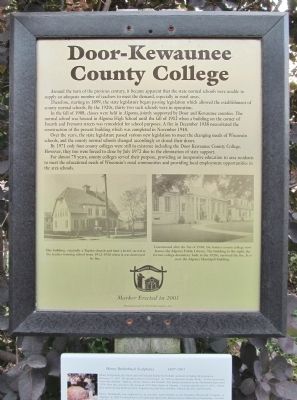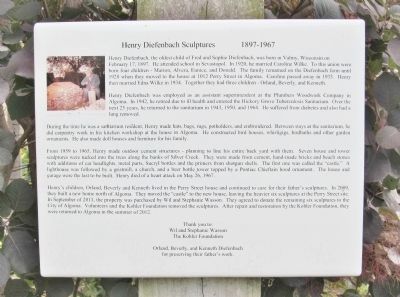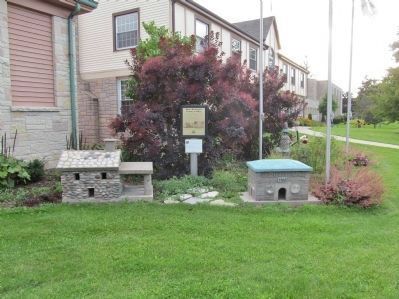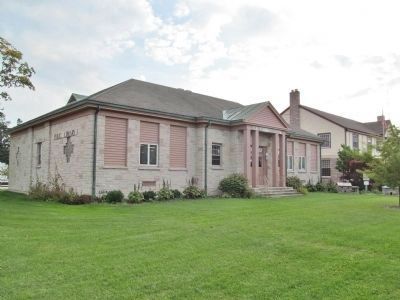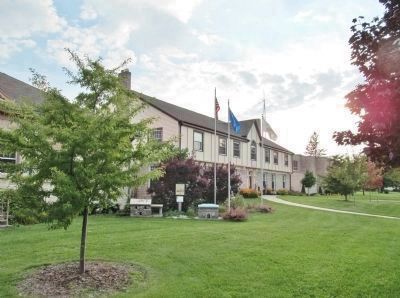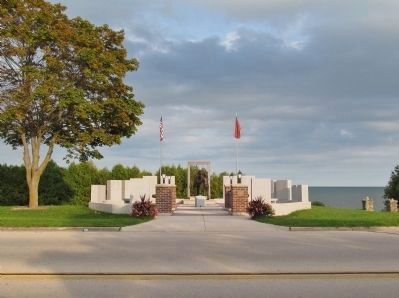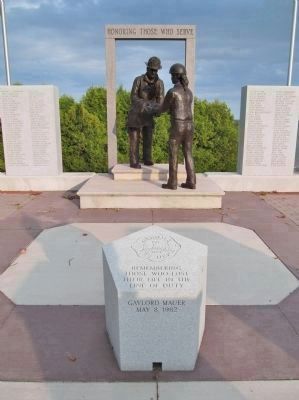Algoma in Kewaunee County, Wisconsin — The American Midwest (Great Lakes)
Door-Kewaunee County College / Henry Diefenbach Sculptures
Around the turn of the previous century, it became apparent that the state normal schools were unable to supply an adequate number of teachers to meet the demand, especially in rural areas.
Therefore, starting in 1899, the state legislature began passing legislation which allowed the establishment of county normal schools. By the 1920s, thirty-two such schools were in operation.
In the fall of 1908, classes were held in Algoma, jointly supported by Door and Kewaunee counties. The normal school was housed in Algoma High School until the fall of 1912 when a building on the corner of Fourth and Fremont streets was remodeled for school purposes. A fire in December 1938 necessitated the construction of the present building which was completed in November 1940.
Over the years, the state legislature passed various new legislation to meet the changing needs of Wisconsin schools, and the county normal schools changed accordingly or closed their doors.
By 1971 only four county colleges were still in existence including the Door-Kewaunee County College. However, they too were forced to close by July 1972 due to the elimination of state support.
For almost 75 years, county colleges served their purpose, providing an inexpensive education to area residents to meet the educational needs of Wisconsin's rural communities and providing local employment opportunities in the area schools.
1897 - 1967
Henry Diefenbach, the oldest child of Fred and Sophie Diefenbach, was born in Valmy, Wisconsin on February 17, 1897. He attended school in Sevastopol. In 1920, he married Caroline Wilke. To this union were born four children - Marion, Alvera, Eunice, and Donald. The family remained on the Diefenbach farm until 1928 when they moved to the house at 1012 Perry Street in Algoma. Caroline passed away in 1933. Henry then married Edna Wilke in 1934. Together they had three children - Orland, Beverly, and Kenneth.
Henry Diefenbach was employed as an assistant superintendent at the Plumbers Woodwork Company in Algoma. In 1942, he retired due to ill health and entered the Hickory Grove Tuberculosis Sanitarium. Over the next 25 years, he returned to the sanitarium in 1943, 1950, and 1964. He suffered from diabetes and also had a lung removed.
During the time he was a sanitarium resident, Henry made hats, bags, rugs, potholders, and embroidered. Between stays at the sanitarium, he did carpentry work in his kitchen workshop at the house in Algoma. He constructed bird houses, whirligigs, birdbaths and other garden ornaments. He also made doll houses and furniture for his family.
From 1959 to 1965, Henry made outdoor cement structures - planning to line his entire back yard with them. Seven house and tower sculptures were tucked into the trees along the bank of Silver Creek. They were made from cement, hand-made bricks and beach stones with additions of car headlights, metal parts, Sucryl bottles and primers from shotgun shells. The first one was called the "castle." A lighthouse was followed by a gristmill, a church, and a beer bottle tower topped by a Pontiac Chieftain hood ornament. The house and garage were the last to be built. Henry died of a heart attach on May 26, 1967.
Henry's children, Orland, Beverly and Kenneth lived in the Perry Street house and continued to care for their father's sculptures. In 2009, they built a new home north of Algoma. They moved the "castle" to the new house, leaving the heavier six sculptures at the Perry Street site. In September of 2011, the property was purchased by Wil and Stephanie Wasson. They agreed to donate the remaining six sculptures to the City of Algoma. Volunteers and the Kohler Foundation removed the sculptures. After repair and restoration by the Kohler Foundation, they were returned to Algoma in the summer of 2012.
Thank you to: Wil and Stephanie Wasson · The Kohler Foundation · Orland, Beverly,
and Kenneth Diefenbach for preserving their father's work.
Erected 2001 by the Kewaunee County Historical Society.
Topics. This historical marker is listed in these topic lists: Education • Man-Made Features. A significant historical date for this entry is February 17, 1897.
Location. 44° 36.395′ N, 87° 26.348′ W. Marker is in Algoma, Wisconsin, in Kewaunee County. Marker is on Fremont Street west of Fourth Street (Wisconsin Highway 42), on the left when traveling west. Marker is at the north side of the Algoma Public Library. Touch for map. Marker is at or near this postal address: 406 Fremont Street, Algoma WI 54201, United States of America. Touch for directions.
Other nearby markers. At least 8 other markers are within 2 miles of this marker, measured as the crow flies. The Church of St. Agnes-by-the-Lake (about 500 feet away, measured in a direct line); American Legion Park (approx. 0.2 miles away); Officer Ronald L. Leist (approx. 0.3 miles away); Christmas Tree Ship Point (approx. 0.4 miles away); Schooner Daniel Lyons (approx. 0.4 miles away); Brickyards (approx. 0.4 miles away); The Lumber Industry in Algoma (approx. 0.6 miles away); Bruemmerville (approx. 1.6 miles away). Touch for a list and map of all markers in Algoma.
More about this marker. photo captions:
• This building, originally a Baptist church and later a hotel, served as
the teacher training school from 1912-1938 when it was destroyed by fire.
• Constructed after the fire of 1938, the former county college now houses the Algoma Public Library. The building to the right, the former college dormitory built in the 1920s, survived the fire. It is now the Algoma Municipal building.
Also see . . .
1. History of the Algoma Public School System. (Submitted on September 25, 2014.)
2. Henry Diefenbach. (Submitted on September 25, 2014.)
Credits. This page was last revised on October 8, 2021. It was originally submitted on September 25, 2014, by Keith L of Wisconsin Rapids, Wisconsin. This page has been viewed 488 times since then and 22 times this year. Photos: 1, 2, 3, 4, 5, 6, 7. submitted on September 25, 2014, by Keith L of Wisconsin Rapids, Wisconsin.
